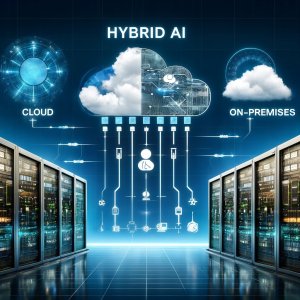Every August, infrastructure professionals make a pilgrimage to VMworld – temporarily in Las Vegas’s Mandalay Bay due to construction in San Francisco – to hear what the oracles of VMware have to say about the future of computing platforms. What started out as a clever way to greatly increase server utilization with no need for application software rewrites, has evolved into a seminal technology for increasing infrastructure plasticity. VMware is an archetype technology for software-defined infrastructure – and VMworld a forum for the community bent on pushing against the limits of computing technology.
What will be the big theme? Well, they’ll be more software-defined everything, new approaches to packaging hardware, and advances in managing computing resources. But the big theme will be the realities of greater data distribution in an increasingly digital world and the emergence of true private cloud computing that fundamentally focuses on bring the cloud experience to distributed data.
Preview of VMworld with Dave Vellante and Stu Miniman. See Wikibon and theCUBE live at VMworld http://siliconangle.tv/vmworld-2017
Against that big theme, here are a few of the issues we’ll be discussing with the Wikibon community at VMworld:
- Additional details regarding the VMware/AWS agreement. Last fall, AWS and VMware entered into a partnership intended to give VMware customers a VMware path to the public cloud. Further details were promised this year, and speculation ran high that they would emerge at this VMworld. Recent press reports suggestion nothing big will happen, but we certainly are focused on how AWS and VMware plan to knit together their respective ecosystems.
- Further evidence that storage is the new CPU. In the last few years, storage technology has advanced 10x through inclusion of flash and associated software in enterprise solutions, while CPU improvements have moderated. The old rules of system design and implementation are evolving; the server is losing primacy to storage, in part driven by advances in data-oriented application forms like machine learning, artificial computing, and edge streaming. What are the new rules? Wikibon foresees an architecture we call “UniGrid,” and we expect to see a lot more clues emerge at VMworld this year.
- Emergence of “appliances.” Software-defined infrastructure creates opportunities for improved packaging and more targeted pricing, especially as digital business transformation creates more specialized needs and tighter market segments. Note that “specialized needs” are not solely defined in functional terms; customers are also defining needs in journey terms, including industry, geography, and legacy technology arrangements. Oracle, for example, has done a nice job of factoring journey requirements into its appliance packaging, but the company has the advantage of pointing all customers toward a single destination: Oracle clouds. The combination of vendor-desired “to-be”possibilities in the VMware universe is considerably larger, but that makes packaging simplicity no less valuable to VMware customers. Indeed, it only expands the range of appliance possibilities.
- Health of the VMware ecosystem. Customers spend about $100B per annum in the VMware ecosystem. VMware’s high growth vSAN solution drives over $260 million in 2016, according to Wikibon figures, NSX, the company’s software defined network offering is headed toward $1B. Both of these solutions represent competitive headwinds and momentum tailwinds for ecosystem suppliers. The company depends on its ecosystem of hardware, software, and networking partners to expand the value and reach of its market presence. At the same time, VMware continues to target pieces of the value chain. The dynamic at a big event like VMworld is a good leading indicator of an ecosystem’s health. We’re not talking mainly about the number of attendees. Are there more sponsors? Are sponsors more varied and innovative? Are more partnerships and combinations being announced? Are the right opportunities being addressed or are companies still trying to fix past problems?
- Making nicer with containers. Generally, container technology from companies like Docker, CoreOS, and Google have leaned heavily on virtual machine technology for security and resource management, but that is starting to change. “System container” options from companies like Canonical offer an alternative, non-emulation-based path that may point to greater resource efficiency and configuration flexibility. The result could be systems that start-up and stop faster, share resources more simply, and more effectively utilize resources. As we move to architectures like UniGrid, these advantages will be amplified. VMware’s vSphere Integrated Container (VIC) adds first-rate Docker support to the vSphere platform, and VMware’s Photon Platform is promising, but the company has to keep pace with rapid changes in the developer world.
- And that serverless computing thing. At VMworld 2016, VMware put forward its vision for cross-cloud support. NSX was especially featured. Since then, serverless computing has gained potency as a way to optimize cloud and resource utilization. We expect a lot more visibility into the practical, long-term relationship between VMware and serverless computing to emerge from VMworld 2017.
Action Item. VMware is – and will remain – an essential enterprise technology for at least another two technology generations. Nonetheless, the steps the company and its ecosystem take now will shape enterprise technology options for years to come. As other, cloud-native technologies further mature, VMworld 2017 may be the most important gathering of VMware pros in years.


